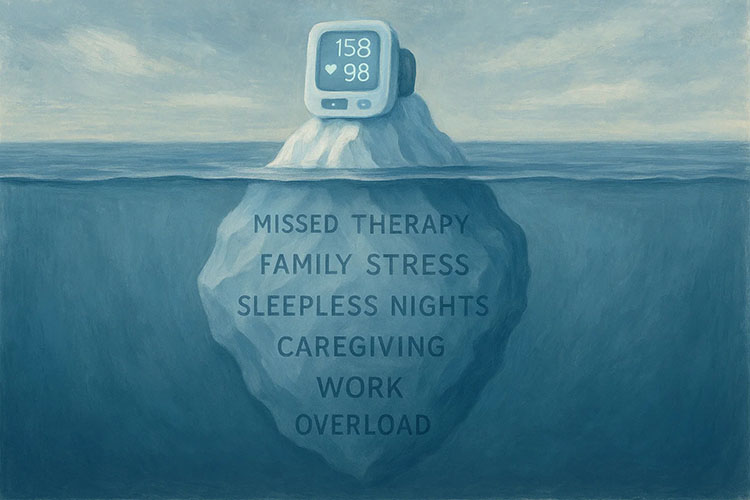
As a healthcare provider, you may already recognize the potential of Remote Patient Monitoring (RPM) to transform patient care. But with countless RPM solutions available, how do you choose the one that best fits your practice's unique needs?
It's a decision that can impact the quality of your patient care and the efficiency of your services.
This blog is a roadmap, pinpointing the essential features that distinguish an effective RPM partnership and a failing one.
Let’s take a look…
What Chronic Conditions are covered?
It's a common misconception that all RPM Program Providers cover all 20 Chronic Conditions.
Some may offer equipment limited to monitoring only a handful of conditions, while others might specialize in a specific area, like managing one specific chronic disease or focusing on prenatal care. This specialization could stem for strategic reasons, or as a response to market demands.
However, it's crucial to recognize that partnering with an RPM provider with a narrow focus could restrict your patient base, limiting the health benefits patients could reap from a more comprehensive RPM service.
This limitation also limits the potential additional revenue your practice could generate through a broader RPM program.
Do the RPM Devices Measure Up?
Now that you've determined the chronic conditions your practice aims to manage with your RPM program, it's time to select devices that align with your goal.
Selecting the correct devices is essential for the effectiveness of your RPM strategy.
RPM devices need to be user-friendly and capable of integrating smoothly with patient portals for real-time monitoring, which is vital for proactive care.
Cellular vs the Rest
The functionality of these devices hinges on their ability to send data effortlessly.
Ideally, RPM devices should be self-sufficient, not requiring additional hardware or apps, which can complicate usage and compliance. Cellular-enabled devices that use SIM cards for data transmission offer a streamlined solution, bypassing the need for patients to navigate technology or for providers to deal with cumbersome setup processes.
Such devices offer a hassle-free experience for patients and extend your practice's reach to those who might not be tech-savvy.
For providers, this simplicity means a wider patient base and, potentially, a more profitable and scalable RPM offering.
Security Compliance
Security is a critical concern for any healthcare practice, especially when it comes to the handling of patient data. Your RPM provider must follow HIPAA regulations, ensuring that all devices used in your RPM program have security protocols. If a provider’s devices lack these protections, it's a red flag!
RPM devices must securely transmit patient vitals to the RPM provider's portal, safeguarding against unauthorized access.
This brings us to the previous point of cellular versus Bluetooth connectivity.
Bluetooth-enabled devices may present potential risks. They can be vulnerable to data breaches, especially if they remain in a discoverable mode, which makes them visible to other devices. If a Bluetooth device needs to communicate with a hub or relies on another device, the risk is even more significant.
On the other hand, cellular-enabled devices offer a more secure solution. With end-to-end encryption, these devices utilize dedicated networks, avoiding the pitfalls of shared connections. They don’t broadcast signals indiscriminately, significantly reducing the risk of data interception.
Patient Management, Compliance, & Billing
Here's where we get to the exciting part of your RPM program: the patient-centric elements.
These aren't just administrative tasks; they're the building blocks that can elevate your RPM service to a new level of profitability and patient care excellence for your practice.
Patient Qualification and Onboarding
First up is patient qualification and onboarding—a critical process that can either streamline your operations or become a bottleneck if not appropriately handled.
The question is, does the RPM provider take charge of this process, or will your practice need to manage it in-house?
Managing onboarding internally can stretch your staff thin and lead to potential problems, from data entry errors to qualifying the wrong patients. It's essential to clarify with the provider whether onboarding support is part of the package or an added expense.
Outsourcing this task to the RPM provider's specialized team can help ensure a smooth launch and minimize costly mistakes down the road.
Data Access and Management
Then there's the matter of data handling. It's vital to have instant access to patient data. It’s useless if it's not readily accessible.
An RPM provider must offer a user-friendly portal where this data is available and easily navigable. Such a portal should enable you to monitor patient trends, access historical data (at least 7 years), and facilitate patient monthly checkups. Additionally, an easy-to-use portal ensures that your staff with different levels of tech literacy can properly access relevant information.
This functionality isn't just a want; it's a must for an effective RPM program, empowering you to make informed decisions and manage your patients’ healthcare plans efficiently.
Billing Gateway
This is the final step in your efforts to translate patient care into revenue. However, the difference between a smooth revenue stream and a billing headache often lies in the tools provided by your RPM partner.
Consider this - will your RPM provider streamline the process with a structured billing queue, facilitating the management of CPT® codes and claims?
Or will you be left to wrestle with a jumbled spreadsheet, sifting through data to "figure it out" and bill your claims?
The right RPM partner should be equipping you with a clear and manageable billing portal queue, ensuring that your path to reimbursement is as efficient as the care you provide.
Bonus Items to Consider
We have already partially covered some of these items, but it’s also good to go over them in further detail so you do not miss anything.
Full Service vs Partial Service
In the realm of RPM, the debate between full-service and self-service models is more than just operational—it's strategic.
If your practice is considering a self-service RPM approach, this means taking on all aspects: device management, patient qualification, patient onboarding, device shipping, patient monitoring, check-ins, and billing.
This can be an overwhelming task, possibly stretching your resources thin and putting your staff in a difficult situation, which might impact the quality of care for your walk-in patients.
Conversely, partnering with a full-service RPM provider can significantly lighten the load.
Such a provider brings a team of experts who take the helm of the RPM process, enabling your staff to focus on what they do best — caring for patients face-to-face. This doesn’t just free up time — it ensures that the quality of care remains high, regardless of whether patients are seen in-person or monitored remotely.
Embracing a full-service RPM solution might be the strategic pivot that enhances your practice's efficiency and patient satisfaction.
A Final Word: Your Path to the Right RPM Provider
Choosing the right RPM provider is an important decision that can redefine patient care and bring in additional income for your practice. It’s about striking the perfect balance between comprehensive chronic condition coverage, quality and secure devices, robust user-friendly portal, compliance, and billing processes.
At Medek RPM, we understand these needs and go beyond them. Our services are designed with the foresight of industry trends and the flexibility to adapt to your practice’s growth. With Medek RPM, you’ll find all the mentioned features and more, creating a partnership that's not just about monitoring health but enhancing patient life and your practice.
Don’t settle for less when you can have the support and innovation that align with your commitment to excellence. Let Medek RPM be the provider that stands with you as you navigate the future of patient care.
Discover how Medek RPM can transform your practice by speaking with an RPM Specialist today!




